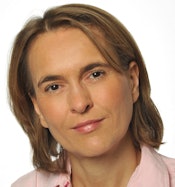
SAN FRANCISCO - Breast MRI is used as an adjunct to mammography for screening women at high risk of breast cancer, but could it be used in average-risk women as well to find cancer earlier? The answer is a resounding yes, according to research presented at the American Society of Clinical Oncology's annual Breast Cancer Symposium (ASCO BCS).
 Dr. Christiane Kuhl, from the University of Aachen in Germany.
Dr. Christiane Kuhl, from the University of Aachen in Germany.
In a study led by Dr. Christiane Kuhl of the University of Aachen in Germany, researchers performed breast MRI scans in addition to standard mammography on more than 2,100 average-risk women at periodic intervals and tracked them over two years. They found that MRI detected many cancers that were not found on mammography, regardless of breast tissue density.
The research results are good news for women who don't have any particular risk of breast cancer, Kuhl told AuntMinnie.com.
"The results are encouraging, even more so in light of the fact that mammographic screening alone is not sufficient in women with heterogeneously dense or dense breast tissue -- and more than half of the female population falls into these categories," she said. "Most of these women are referred to screening breast ultrasound, but this modality is less sensitive than MR and has a low positive predictive value."
Too costly?
One of the criticisms of breast MRI is that it is costly. So how could the modality be incorporated into a regular breast cancer screening program? Abbreviated MR protocols would help, Kuhl said. At the ASCO BCS meeting in 2013, she presented data showing that a streamlined protocol for breast MRI cut image acquisition and reading time to just three minutes -- without compromising its performance. She has also published research to this effect in the Journal of Clinical Oncology (June 23, 2014).
"Based on our previous results on abbreviated breast MRI, we would predict that the costs of an MR examination will come down, which would make the modality more accessible," she said.
In her study presented at ASCO 2015, 2,120 asymptomatic, average-risk women ages 40 to 70 underwent a total of 3,861 breast MRI exams every 12, 24, or 36 months. The women were tracked an additional two years thereafter.
Kuhl's team found breast cancer in 61 women, with 20 ductal carcinomas in situ and 41 invasive cancers; 21 were atypical ductal hyperplasia or lobular intraepithelial neoplasia. Of these cancer cases, 48 were diagnosed at initial screening by MRI alone, for a supplemental cancer detection rate of 22.6 per 1,000 women. Thirteen women were found to have additional cancers, and 12 of these were detected by screening MRI alone, for a detection rate of 6.9 per 1,000 (the remaining incident cancer was found by MRI and mammography).
These supplemental cancer detection rates were not influenced by breast tissue density. Overall, screening mammography in this population had a specificity rate of 97.1%, and a false-positive rate of 2.9%. The interval cancer rate was 0%, regardless of screening interval, Kuhl's group found.
Despite decades of mammographic screening programs conducted in Europe and the U.S., breast cancer continues to represent the most common cause of cancer death in women in Europe and the second in the U.S., according to Kuhl.
"This, together with the fact that early diagnosis of breast cancer does translate into significant survival benefit, suggests that there is room for improved diagnosis of breast cancer in women of average risk," she said.
Ultimately, the aim of breast cancer screening is not to detect all breast cancers and their precursors, but rather those that could cause harm, Kuhl said.
"The goal of breast cancer screening must be to develop imaging methods that combine a maximum sensitivity for prognostically relevant disease with a desirable lack of sensitivity for disease that is prognostically unimportant," she said. "And this is exactly what breast MR can offer."



.fFmgij6Hin.png?auto=compress%2Cformat&fit=crop&h=100&q=70&w=100)





.fFmgij6Hin.png?auto=compress%2Cformat&fit=crop&h=167&q=70&w=250)











